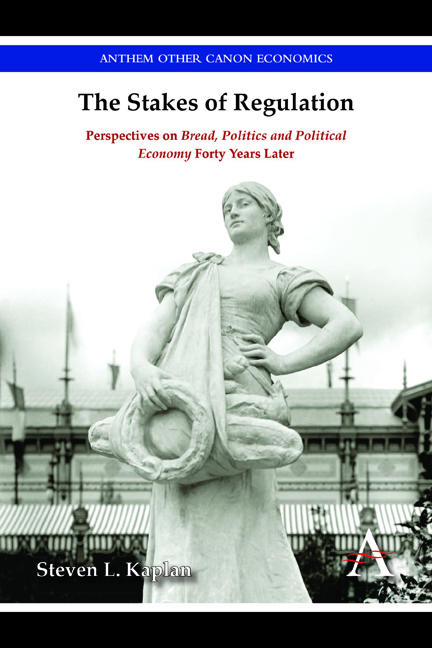Book contents
- Frontmatter
- Dedication
- Contents
- Introduction
- Chapter I (Re-)Thinking Regulation: Police, Prices, Markets
- Chapter II Agriculture and the French Economy of the Old Regime
- Chapter III Collective Action and Its Actors: The Moral Economy and the Market, the People and the Elites, Disorder and Order
- Chapter IV The Parlements in the Age of Economic Enlightenment
- Chapter V Kings and Ministers: Politics and Policies, Finance and Subsistence
- Chapter VI The New Historiography of Political Economy
- Chapter VII Famine, Dearth and Food (In-)Security
- Afterword
- Index
Chapter I - (Re-)Thinking Regulation: Police, Prices, Markets
Published online by Cambridge University Press: 20 July 2018
- Frontmatter
- Dedication
- Contents
- Introduction
- Chapter I (Re-)Thinking Regulation: Police, Prices, Markets
- Chapter II Agriculture and the French Economy of the Old Regime
- Chapter III Collective Action and Its Actors: The Moral Economy and the Market, the People and the Elites, Disorder and Order
- Chapter IV The Parlements in the Age of Economic Enlightenment
- Chapter V Kings and Ministers: Politics and Policies, Finance and Subsistence
- Chapter VI The New Historiography of Political Economy
- Chapter VII Famine, Dearth and Food (In-)Security
- Afterword
- Index
Summary
During the past forty years, very few studies have appeared dealing with the provisioning trade. This dearth of production is especially striking in the 1970s and ‘80s when social history still rode its quasi-hegemonic tide, barely challenged until the run-up to the bicentennial of the French Revolution. Long before the relatively recent globalizing turn, foreign trade, largely focused on colonial relations, commanded substantial interest. Commerce within France, dominated by cereals, in terms of magnitude and significance, elicited hardly any curiosity. It seems hard to impute this situation to the considerable older literature, scholarly and “antiquarian,” denser in its concern for the regions than for the capital, which was very often badly dated. Nor did the great “urban” theses, under the aegis or influence of Ernest Labrousse of the Sorbonne, former secretary to Léon Blum, champion of an incipient quantitative socioeconomic approach, more or less in the spirit of the Annales, devote keen attention to the subsistence question. Labrousse himself seemed to have exhausted the arena of price studies; and the uncertainty regarding the discreet, herculean labors of Jean Meuvret, another pioneer in the socioeconomic realm, specialized in agricultural, especially grain-related issues—how much of what was bruited had he completed and when, if ever, would it come out?—doubtless had a dissuasive effect. My Provisioning Paris: Merchants and Millers in the Grain and Flour Trade During the Eighteenth Century (Ithaca, 1984), the first probing research into the elementary structures of the grain and flour trade in the greater Paris area, a socioeconomic and cultural study blending quantitative and qualitative analyses, did not spur any vocations, notwithstanding its efforts to recast notions of markets and of regulation. I was especially disappointed that no one explored further the milling trade/industry, still a largely virgin domain of inquiry, despite its crucial place in the French industrial and social economy, and despite the transformative impact of its technological innovation and business practices. Indeed, generally speaking, all remained quiet on the historiographical front of what was called the grain–flour–bread circuit: no wheels turning, stones grinding or dough fermenting.
As far as the market was concerned—as concept, ideology, institution, set of practices—we seemed to have reached the end of historiography, if not of history: no one problematized it; it was what it was supposed to be by those who fully elaborated its code and destiny during the nineteenth century.
- Type
- Chapter
- Information
- The Stakes of RegulationPerspectives on Bread, Politics and Political Economy Forty Years Later, pp. 1 - 60Publisher: Anthem PressPrint publication year: 2015

